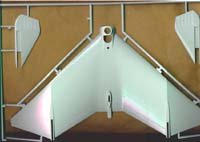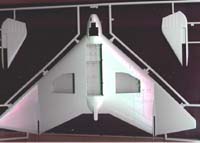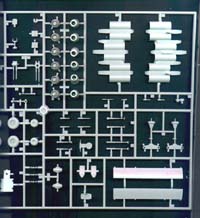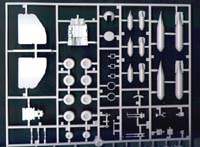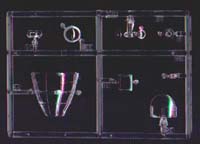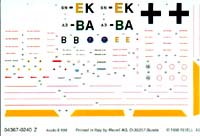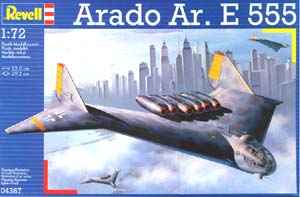Revell Germany 1/72 Arado Ar.E-555 Long Distance Bomber Kit No: 04367 | | HISTORY: (From Revell's instruction sheet) "In mid 1944, the Arado development group was instructed by the German Air Ministry to carry out design studies for a long distance bomber with the new wing shape according to the guidelines set. The requirement was for a long-range, high-speed, all-wing bomber with up to eight turbojet engines to carry a bomb load of over 4000 kg over a range of about 5,000km. One of its required capabilities was to reach distant targets such as New York. The fuselage was circular and aerodynamically designed. The three man crew was to be accommodated in a pressurized, fully-glazed cabin, positioned ahead of the center of gravity. The design take-off weight, with a normal bomb load of 4,000 kg, was 24 tonnes. The armament of the E 555/1 was to consist of two rigid type MK 103 cannons mounted in the wing roots and one remote controlled gun turret on top of the cabin, with two backwards firing MG 151/20 machine-guns. The remote aimed tail gun turret, which was also to be equipped with two MG 151/20's, was controlled via a periscope from a pressurized gun turret behind the crew cabin. On December 22nd, 1944 the development high commission (EHK) ordered the immediate cessation of all work on the Arado E 555/1 project. Thus this promising design, together with a large number of other advanced projects with other aircraft manufacturers, was sacrificed following incomprehensible decisions by the German Air Ministry." Main features of the Arado E 555/1 Engines 6 x BMW 109-003A
Altitude 13000 to 15000m
Penetration 3200 km
.......With auxilary tanks 4800 km
Cruising speed 715 km/h
Max speed 860 km/h Whats in the box?:
The kit comes in a large, end opening box. Inside one finds all three
of the large, light gray molded plastic parts trees in a single cello
bag. Also, in this large cello bag is a smaller cello bag containing the
clear parts.
A large decal sheet is provided with a multitude of stencil marks and the usual national crosses and aircraft call letters. Since this kit is manufactured in Germany it is understandable that the swastikas are absent. This sheet has a protective wax-paper sheet covering it's face. The first large parts tree holds three parts: the upper fuselage/wings and two tail rudder halves. The second large parts tree holds: the lower fuselage/wings and the other two tail rudder halves. A third, slightly larger parts tree holds the rest of the aircrafts parts: two sizes of bombs, the six jet engine parts, the interior, the landing gear and wheels, landing gear doors, machine-guns etc. (no less than 83 parts on this tree) The clear parts tree holds the cabin and gun turret transparencies. (9 parts here) Rounding out the kit is the decal sheet (mentioned already) and the large instruction booklet. This instruction booklet (8 1/4" x 11 5/8" format) is 16 pages long. There is also a color brochure enclosed in the kit that advertises numerous military books, for both aircraft and armor, in the German language. Page one gives a black and white photo of the model made up and the history of the aircraft in German and English. Pages 2-4 give warnings and start up instructions in a dozen different languages. Page 5 has a international assembly symbol translation guide and cross-reference of the alphabet letters, used throughout the assemblies, as to what colors those are. Page 6 is parts tree drawings. Pages 7 through 13 give us 26 assembly steps. pages 14 through 16 is the paint scheme and markings drawings. These are very, very busy drawings because of the multitude of stencil markings etc. given on the decal sheet. Two marking schemes are given. One is for KG 100 in 1948 (if the aircraft had ever gone into production that is!). The second one is for KG 200 in 1948. One of these schemes wants the upper surface fully mottled and the other just wants large darker blotches of RLM 75. Conclusion I got into these conceptual aircraft kits awhile back, when I bought three other of this type of aircraft kit from Revell of Germany. Those three were: the Messerschmitt P-1099B/1, the Messerschmitt P-1099, and the Blohm Und Voss BV P-194. The 2 Messerschmitt's are what the Me-262 could have evolved into...a bomber and a heavy fighter. The Blohm and Voss is what the BV-141 could have developed later into....it has both an engine and a jet and a more aerodynamic shape. Planet brand makes a whole bunch of these conceptual aircraft too, as well as some from Huma. These might have actually hit the skys over Germany if the war had dragged on longer. For a conceptual aircraft kit, this E 555 is sure detailed and beautifully engraved. Highly recommended. Revell of Germany gives the skill level on the box as "3", which is 'a more demanding kit with over 100 parts'. So..it should not be too hard for any modeler to do. Don't forget to add the 2 x 16gr of weight to the forward wing roots, in assembly step 5, as apparently this model will be a tail dragger without them. If you are tired of the same old operational WWII aircraft, this will be a real change. The Germans had a lot of things on the drawing board, late in the war, and most of these conceptions never got much further than that. I got this kit, in the vendor's room, at the last contest I attended. The dealer only wanted $3.00 for it!! I am a sucker for a genuine BARGAIN...but...then...aren't we all? I know that the full MSRP of this kit is quite a bit more. Highly recommended. | 


 



  
    |
